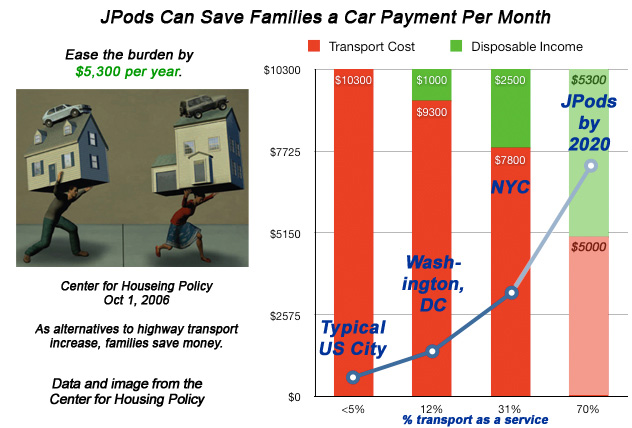- Home
- About
- Advantages of JPods
- Capacity
- Conservation
- Economics
- 10X Capital Savings
- Base the $ on Energy
- Dangerous Economic Assumptions
- Free Markets
- Jobs
- Land Use
- Linear Barriers to Commerce and Nature
- Metrics: Replace GDP with Disposable Energy
- Parking
- Supply_Demand
- Free Market Efficiency
- Net Energy Decline
- Inaccurate IEA Forecasts
- 'Titanic' Oil Economy
- Paychecks and Oil
- History
- Lifeboat Paradox
- Links
- Management Team
- Metrics
- Payback
- Peak Oil
- Project Flow
- Recipe
- Solar
- Technologies
- What are JPods
- Why JPods®
- Be Involved
- Key Steps
- Franchise Agreement (draft)
- Solar Mobility Act
- Own and Operate a JPods Network
- Become a JPods Supplier
- Design Your Own JPods Network
- Investors
- Spread The Word
- 8-80 Cities
- Agreements
- Cities of the Sun
- Domestic War by 2023
- Kitty Hawk Network
- Regulation
- San Jose State
- Scale Model
- Railroad 1862
- News
- Cities
- Contacts
You are here
Affordable
Working Family Costs
 In cities with less than 5% public transportation, a typical working family ($20-50,000 income per year) spends $10,300 on transportation. In cities averaging 12% public transportation that cost drops to $9,300; fewer car payments, insurance, gas and parking results in an extra $1,000 per year of disposable income.
In cities with less than 5% public transportation, a typical working family ($20-50,000 income per year) spends $10,300 on transportation. In cities averaging 12% public transportation that cost drops to $9,300; fewer car payments, insurance, gas and parking results in an extra $1,000 per year of disposable income.
It is practical to privately finance a 20% displacement of oil-based transportation in the next three to six years, increasing a working family's disposable income by $2,000.
In 10-12 years, it is possible to cut transportation cost by $5,000 by displacing 70% of oil-based transport; about a $5,000 increase in disposable income.
Construction, manufacturing and operations jobs will be created.
Driving Parasitic Mass, the mass we pay to move that is not cargo or passengers, towards zero results in dramatic cost reductions.
Capital Costs
Driving Parasitic Mass towards zero decreases the mass, cost and complexity of the capital infrastructure.
Ultra-light infrastructure can be deployed more quickly and with less ecological and economic impact on the community.
Operational Costs
Energy use is affected by many factors. The very consistent rolling nature of rails greatly decreases the cost to keep railed vehicles rolling.
Maintenance Costs
Maintenance increases as a 4th power of axle weight. Using lighter vehicles, such as JPods, can greatly deacrease the cost associated with maintaining our transportation infrastructure.
Archive Site
Theme by Danetsoft and Danang Probo Sayekti inspired by Maksimer